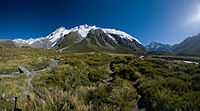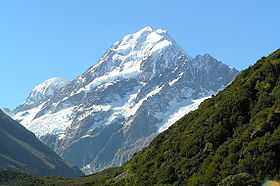Aoraki/Mount Cook National Park
| Aoraki/Mt Cook National Park | |
|---|---|
|
IUCN category II (national park) | |
 Map of New Zealand | |
| Location | South Island, New Zealand |
| Nearest city | Mount Cook Village |
| Coordinates | 43°44′0″S 170°6′0″E / 43.73333°S 170.10000°ECoordinates: 43°44′0″S 170°6′0″E / 43.73333°S 170.10000°E |
| Area | 707 km² |
| Established | 1953 |
| Governing body | Department of Conservation |



Aoraki/Mount Cook National Park is in the South Island of New Zealand near the town of Twizel. Aoraki/Mount Cook, New Zealand's highest mountain and Aoraki/Mount Cook village lie within the park. The area was gazetted as a national park in October 1953 and consists of reserves that were established as early as 1887 to protect the area's significant vegetation and landscape.[1]
Geography
The park covers a little over 700 km2. Glaciers cover 40% of the park area, notably the Tasman Glacier on the slopes of Aoraki/Mt Cook.[1]
Of New Zealand's 20 peaks over 3,000 metres, all except Mount Aspiring / Tititea lie in the park. These include New Zealand's highest mountain, Aoraki/Mt Cook, at 3753 metres. Other prominent peaks include Mt Tasman, Mt Hicks, Mt Sefton and Mt Elie de Beaumont. The mountains of the Southern Alps in general are young, less than ten million years old, and are still building. Uplift in the region of the national park is at the rate of 5-10 mm per year. It's estimated that approximately 25 km of uplift has occurred, however the rate of uplift has been countered by erosion.[2]
The park borders Westland Tai Poutini National Park along the Main Divide. Together they form part of Te Wahipounamu South Westland World Heritage Site, recognised for its outstanding natural values.[1]
Flora and fauna
More than 400 species of plants make up the vegetation in Aoraki/Mount Cook National Park, which include more than 100 introduced plant species such as the colourful Russell lupin, the wild cherry and wilding pines. Under normal circumstances, forest grows to about 1300m, and snow tussock grassland between 1300m and 1900m. At the highest rocks of Aoraki/Mount Cook, around 14 species of lichen have been found.[3] Most of the park is above the tree line so that the plant life consists mainly of alpine plants such as the Mount Cook lily, (Ranunculus lyallii), the largest buttercup in the world, large mountain daisies and wild Spaniard or spear grass.[1]
There are about 35[4] to 40 species of birds in the park and include the kea, the only alpine parrot, and the well-camouflaged pipit. The kea is now only found in the Southern Alps. Small insectivores such as the riflemen/tïtitipounamu and the fantails/pïwakawaka live in the low forest and scrub, along with small numbers of two larger birds, the pigeon and morepork. Introduced species such as finches and sparrows live throughout the bush. The tiny rock wren, a threatened species, is the only permanent resident high on the mountains.[4] The Black Stilt or Kakī, rarest wading bird in the world, lives in the Tasman riverbed.[1]
The park is home to many invertebrates, including large dragonflies, crickets, grasshoppers, 223 recorded moth species and 7 native butterflies.[5] A black alpine wētā, also known as the Mount Cook flea is found above the snowline. The jewelled gecko lives in the park but is rarely seen.[1] Introduced Red deer, chamois and Himalayan tahr can be hunted.[6]
Weather
Weather conditions can change rapidly.[7]
Recreation
The park is popular for mountaineering, hunting, tramping/hiking, skiing and ski touring. The Department of Conservation administers activities in the park.
Mountaineering
The spectacular peaks of the Aoraki/Mount Cook region have attracted climbers from all over the world for the last 100 years. The dramatic nature of these mountains provides a rare challenge. The combination of heavy glaciation, tremendous vertical scale and unpredictable weather means that they are not readily won. To climb successfully here requires skill, fitness, patience, and a great respect for the mountains. Mountaineering on the Aoraki/Mount Cook massif is a hazardous activity.[8]
Area history

- 1642 - Aoraki sighted by Abel Tasman
- 1770 - Captain Cook named the Southern Alps
- 1851 - Captain Stokes of the survey ship HMS Acheron gave the name Mt Cook to Aoraki
- 1884 - First Hermitage built under the direction of Frank Huddleson
- 1894 - First ascent of Aoraki/Mount Cook, on Christmas Day, by Jack Clarke, Tom Fyfe and George Graham
- 1910 - Freda du Faur became the first woman to climb Aoraki/Mount Cook
- 1911 - The vital swing bridge is built in the Hooker Valley
- 1913 - First ascents of the footstool and Mt Sefton made by Freda du Faur's climbing party
- 1913 - Hermitage first ravaged by floods in January, then destroyed beyond repair by floods two months later
- 1914 - First fatal accident, when three men caught in avalanche on Linda Glacier
- 1914 - Second Hermitage opened, on different site
- 1957 - Second Hermitage razed to the ground
- 1959 - First school opens, Aoraki Mt Cook School
- 1961 - Passenger flights begin by Mount Cook Airline, now part of Air New Zealand Link
- 1982 - Mark Inglis trapped in snow cave
- 1991 - Avalanche of 10 million cubic metres of snow and rock causes 10 metres to be lost off the top of Aoraki/Mount Cook[9][10] Two decades of erosion of the ice cap exposed after this collapse reduced the height by another 30m to 3724 m, as revealed by new GPS data from a University of Otago climbing expedition in November 2013.[11][12][10] Two decades of erosion of the ice cap exposed after this collapse reduced the height by another 30m to 3724 m, as revealed by new GPS data from a University of Otago climbing expedition in November 2013.[13][14]
- 1998 - The Ngāi Tahu Claims Settlement Act officially recognises the original name, renaming the mountain Aoraki/Mt Cook[15]
See also
- Aoraki / Mount Cook
- List of mountains of New Zealand by height
- Southern Alps
- National parks of New Zealand
- Forest parks of New Zealand
References
- ↑ 1.0 1.1 1.2 1.3 1.4 1.5 "Aoraki/Mount Cook National Park". Department of Conservation. Retrieved 14 January 2012.
- ↑ "Aoraki/Mount Cook Education Resource" (PDF). Department of Conservation. 2009. p. 7. Retrieved 14 July 2010.
- ↑ "Aoraki/Mount Cook Education Resource" (PDF). Department of Conservation. 2009. p. 17. Retrieved 14 July 2010.
- ↑ 4.0 4.1 "Aoraki/Mount Cook Education Resource" (PDF). Department of Conservation. 2009. p. 18. Retrieved 14 July 2010.
- ↑ "Aoraki/Mount Cook Education Resource" (PDF). Department of Conservation. 2009. p. 19. Retrieved 14 July 2010.
- ↑ "Aoraki/Mount Cook - hunting". Department of Conservation. Retrieved 14 January 2012.
- ↑ Southern Alps, queenstown.net.nz
- ↑ Aoraki/Mount Cook Expedition | Summer 2014/15 alpineguides.co.nz
- ↑ . The landslide carried with it another 40 million cubic metres of rock and ice.The impact caused an earth quake of 3.9 on the Richter scale. <P207 In search Of Ancient NZ.Campball and Hutching.GNS science/Penguin.2011.> Michael J. Crozier. "Mt Cook landslide". Te Ara - the Encyclopedia of New Zealand. Retrieved 3 May 2007.
- ↑ 10.0 10.1 T. J. Chinn; M. J. McSaveney (1992). "Mount Aoraki (Mount Cook) rock avalanche". Tai Awatea - Knowledge Net (More of Te Papa online). Retrieved 3 May 2007.
- ↑ "Height of NZ's tallest peak Aoraki/Mt Cook slashed by 30m". NZ Herald. 16 January 2014. Retrieved 16 January 2014.
- ↑ Otago-led study revises height of Aoraki/Mt Cook
- ↑ "Height of NZ's tallest peak Aoraki/Mt Cook slashed by 30m". NZ Herald. 16 January 2014. Retrieved 16 January 2014.
- ↑ Otago-led study revises height of Aoraki/Mt Cook
- ↑ Graham, Doug (13 October 1998). "Ngai Tahu Settlement Section 3: Aoraki/Mount Cook". New Zealand Government. Retrieved 10 June 2012.
External links
| Wikimedia Commons has media related to Aoraki/Mount Cook National Park. |
| Wikivoyage has a travel guide for Aoraki Mount Cook National Park. |
- Aoraki/Mount Cook National Park
- Aoraki/Mount Cook National Park Education Resource 2009
- Mt Cook: Does reaching summit outweigh risks?
| ||||||||||||||||||||